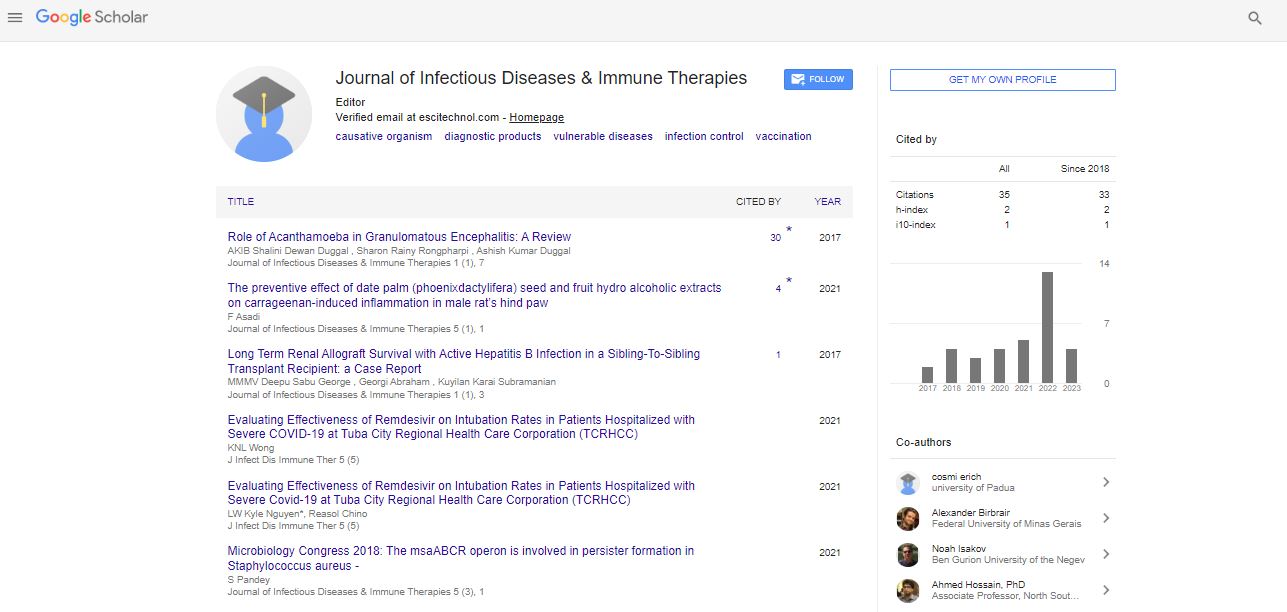Perspective, J Infect Dis Immune Ther Vol: 5 Issue: 6
Gastrointestinal Disorder Due to Irritable Bowel Syndrome
Jay Turnbul*
Department of Immuno Therapy, University of Melbourne, Australia
*Corresponding Author : Jay Turnbul
Department of Immuno Therapy, University of Melbourne, Australia, E-mail: jayturnbullwork@cloud.com
Received: November 01, 2021; Accepted: November 15, 2021; Published: November 22, 2021
Citation: Turnbul J (2021) Gastrointestinal Disorder Due to Irritable Bowel Syndrome. J Infect Dis Immune Ther 5: 6.
Description
Irritable Bowel Syndrome (IBS), also known as spastic or nervous colon, and spastic bowel, is a functional gastrointestinal illness defined by a collection of symptoms that include stomach pain and changes in bowel movement consistency. These symptoms can last for months or even years. It is divided into four categories based on whether diarrhea, constipation, both (mixed/alternating), or none (IBS- D, IBS-C, IBS-M/IBS-A, or IBS-U, respectively). IBS has a detrimental impact on one's quality of life and can lead to missed school or work. People with IBS are more likely to suffer from anxiety, serious depression, and chronic fatigue syndrome. The exact cause of IBS is unknown. Combinations of gut–brain axis abnormalities, gut motility disorders, pain sensitivity, infections (particularly small intestinal bacterial overgrowth), neurotransmitters, hereditary factors, and food sensitivity are among the theories. An intestinal infection or a stressful life event can cause symptoms to appear. In the absence of alarming signs and when all other possibilities have been ruled out, the diagnosis is based on symptoms. A family history of inflammatory bowel disease, starting at more than 50 years of age, weight loss, blood in the stool, and a family history of inflammatory bowel disease are all concerning signs. Celiac disease, microscopic colitis, inflammatory bowel disease, bile acid malabsorption, and colon cancer are among illnesses that might appear similarly.
The goal of treatment is to alleviate the symptoms. Dietary adjustments, medication, probiotics, and psychotherapy are some of the options. Increased soluble fiber intake, a gluten-free diet, or a short-term diet low in fermentable oligosaccharides, disaccharides, monosaccharide’s, and polyols are examples of dietary measures (FODMAPs). Loperamide is a drug that can aid with diarrhoea, whereas laxatives can help with constipation. Antidepressants may help to alleviate pain and improve overall symptoms. Patient education and a positive doctor–patient connection are critical components of treatment. IBS is thought to affect 10–15 percent of the population in the developed countries. The prevalence varies by nation (from 1.1 percent to 45.0 percent) and the criteria used to characterize IBS; nevertheless, when the results of many researches are combined, a figure of 11.2 percent is calculated. In South America, it is more frequent, while in Southeast Asia, it is less common. It affects twice as many women as it does men, and it usually strikes before the age of 45.
As people get older, the illness appears to become less common. IBS has no bearing on life expectancy or the development of other major disorders. The illness was originally described in 1820, and the name "irritable bowel syndrome" was first used in 1944. IBS is divided into four categories: diarrhea-predominant (IBS-D), constipation-predominant (IBS-C), mixed/alternating stool pattern (IBS-M/IBS-A), and pain-predominant (IBS-P).IBS can have an immediate beginning in some people and develop after an infectious disease that includes two or more of the following symptoms: fever, vomiting, diarrhoea, or a positive stool culture. As a result, "post infectious IBS" has been coined to describe this postinfectious illness (IBS-PI). Abdominal pain or discomfort, together with regular diarrhoea or constipation and a change in bowel habits, are the most common symptoms of IBS. Symptoms normally manifest as acute bouts that last a day or less, however repeated attacks are possible. There may be a sense of incomplete evacuation (tenesmus) or bloating, as well as a sense of urgency for bowel motions.
Bowel movements can help ease symptoms in some circumstances. People with IBS are more likely than others to experience gastro esophageal reflux, genitourinary system problems, fibromyalgia, headaches, backaches, and psychological symptoms like sadness and anxiety. After an acute gastrointestinal infection, the chance of having IBS increases six fold. Young age, prolonged fever, anxiety, and depression are also risk factors after infection. While psychological factors like sadness or anxiety have not been proved to cause or impact the onset of IBS, they may play a role in the persistence and intensity of symptoms. Nonetheless, they have the potential to exacerbate IBS symptoms and lower quality of life. Antibiotic use has also been linked to an increased incidence of IBS. Genetic abnormalities in innate immunity and epithelial homeostasis have been linked to the development of both post-infectious and other forms of IBS, according to research.
 Spanish
Spanish  Chinese
Chinese  Russian
Russian  German
German  French
French  Japanese
Japanese  Portuguese
Portuguese  Hindi
Hindi 